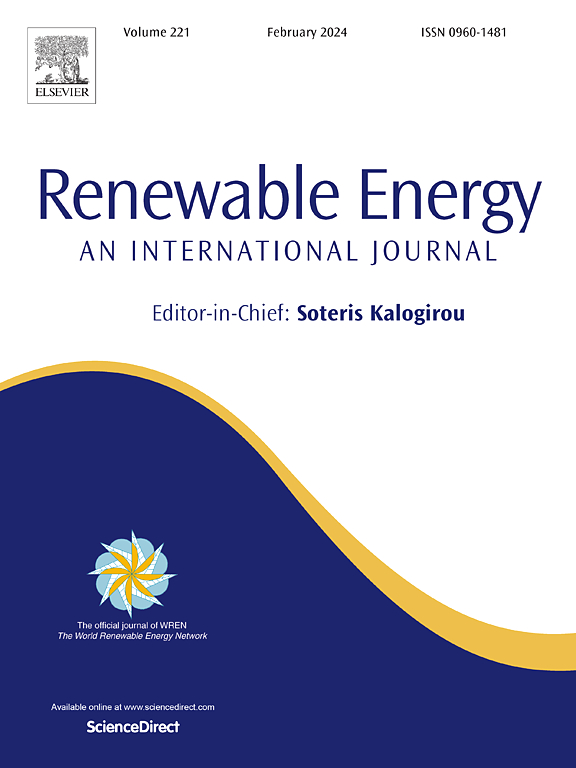A focus-shifted asymmetric compound parabolic concentrator and its application in concentrating bifacial photovoltaic system
IF 9.1
1区 工程技术
Q1 ENERGY & FUELS
引用次数: 0
Abstract
To improve the optical performance of typical non-tracking asymmetric concentrator —Maximum Reflector Collector (MaReCo), this study proposed a novel focus-shifted asymmetric compound parabolic concentrator (FSACPC). The optical performance of FSACPCs with different geometric concentration ratios was investigated first. Then to further verify the potential of FSACPC for application in concentrating bifacial photovoltaic (CBPV) system, optical-thermal-electrical coupling models for FSACPC-CBPV and MaReCo-CBPV systems were established to study the variations of thermal and electrical performances with the light incident angle θin. Finally, the electrical performance and technical economy of FSACPC-CBPV system were compared with those of monofacial photovoltaic (MPV) system with the same solar receiving area under real irradiance conditions. The results show that, compared with MaReCo, FSACPC achieves a larger maximum light acceptance angle and demonstrates higher irradiance distribution uniformity in non-shadow states. FSACPC's maximum irradiance at the critical incident angle θcr decreases by at least 38.80 %, and the average solar radiant energy per unit concentrator area reaches a relative improvement rate of 8.29 %. Moreover, FSACPC-CBPV system has a 32.37 % lower maximum temperature of crystalline silicon cell (SC) layer at θcr than MaReCo-CBPV system, and exhibits larger temperature distribution uniformity. Within the same light acceptance range, while FSACPC-CBPV system having higher comprehensive electrical efficiency, its average total electrical power is also 13.06 % higher than that of MaReCo-CBPV system. Under the irradiance conditions of four typical days, the total electrical power per unit cost of FSACPC-CBPV system can be increased by at least 26.84 % compared with MPV system (at noon on the summer solstice). The levelized cost of energy (LCOE) of FSACPC-CBPV system with 1.7 of geometric concentration ratio is 0.196 CNY/kWh.
一种聚焦移位的非对称复合抛物面聚光器及其在双面聚光系统中的应用
为了提高典型的非跟踪非对称聚光器-最大反射集热器(MaReCo)的光学性能,本研究提出了一种新型的移焦非对称复合抛物面聚光器(FSACPC)。首先研究了不同几何浓度比的FSACPCs的光学性能。然后,为了进一步验证FSACPC在聚光双面光伏(CBPV)系统中的应用潜力,建立了FSACPC-CBPV和MaReCo-CBPV系统的光热电耦合模型,研究了热电性能随光入射角θin的变化规律。最后,在实际辐照度条件下,比较了FSACPC-CBPV系统与相同太阳能接收面积的单面光伏(MPV)系统的电学性能和技术经济性。结果表明,与MaReCo相比,FSACPC在非阴影状态下实现了更大的最大光接受角和更高的辐照度分布均匀性。FSACPC在临界入射角θcr处的最大辐照度至少降低了38.80%,单位聚光面积的平均太阳辐射能相对提高了8.29%。在θcr处,FSACPC-CBPV体系的晶硅电池(SC)层最高温度比MaReCo-CBPV体系低32.37%,温度分布均匀性更强。在相同的光接受范围内,FSACPC-CBPV系统的综合电效率更高,但其平均总电功率也比MaReCo-CBPV系统高13.06%。在四个典型日的辐照度条件下,FSACPC-CBPV系统的单位成本总电功率比MPV系统(夏至中午)至少增加26.84%。几何浓度比为1.7的FSACPC-CBPV系统的平准化能源成本(LCOE)为0.196元/千瓦时。
本文章由计算机程序翻译,如有差异,请以英文原文为准。
求助全文
约1分钟内获得全文
求助全文
来源期刊

Renewable Energy
工程技术-能源与燃料
CiteScore
18.40
自引率
9.20%
发文量
1955
审稿时长
6.6 months
期刊介绍:
Renewable Energy journal is dedicated to advancing knowledge and disseminating insights on various topics and technologies within renewable energy systems and components. Our mission is to support researchers, engineers, economists, manufacturers, NGOs, associations, and societies in staying updated on new developments in their respective fields and applying alternative energy solutions to current practices.
As an international, multidisciplinary journal in renewable energy engineering and research, we strive to be a premier peer-reviewed platform and a trusted source of original research and reviews in the field of renewable energy. Join us in our endeavor to drive innovation and progress in sustainable energy solutions.
 求助内容:
求助内容: 应助结果提醒方式:
应助结果提醒方式:


